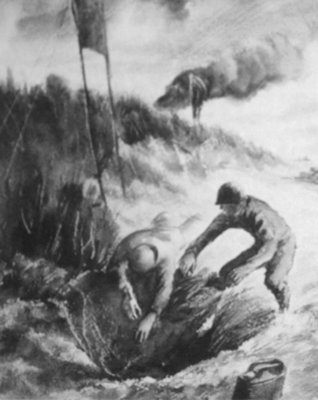
Two years ago, there was a man looking for Alexander Russo who presumed him to be dead.
He had every reason to believe that—by all accounts, Mr. Russo should have been many years ago. The artist had stared down his mortality more times than he could count.
On and off over the last 14 years, Mr. Russo has finally pieced together his life’s journey into a self-published memoir, “Combat Artist: A Journal of Love and War”—323 pages exploring his artistic roots, dizzying career, numerous loves and, most notably, his days and nights serving as a combat artist during World War II.
“I grew up very disciplined. I think that was good for me,” Mr. Russo said last week during a telephone interview from his home in East Hampton. “Looking back, it kept me going through some really rough times.”
It was the early 1940s when Mr. Russo found himself standing before the draft board, pleading his case. The young man explained he had won a scholarship to study art at Pratt Institute—barring him from participating in the war effort.
The “seedy looking sergeant” met him with a blank stare, the memoir reads.
Not long after, Mr. Russo enlisted in the Navy, attended boot camp and eventually landed himself a relatively comfortable position at the graphic unit in White Plains, where he could exercise his creative muscle by drawing posters while serving his country.
But three months later, he was transferred to an intelligence unit in Norfolk, Virginia—where he worked on models and maps, and was miserably fed up—driving him to, first, join a task force headed for Africa and, when he returned, to volunteer for the invasion of Normandy.
Sketch book in hand at all times—a “catharsis,” he said—he documented the wreckage, prisoners and dismembered bodies he saw all around him. He is the youngest combat artist to have drawings and paintings in the Navy’s Historical Records of World War II.
“I couldn’t believe what I was seeing,” he said. “But by drawing, it made me realize who I was, in terms of the whole war. And being able to capture this and put it down, to me, this was a great release.”
His accomplishments did not come without a great deal of post-traumatic stress. To this day, a car backfiring or an airplane flying too close overhead will trigger intense flashbacks, he said, putting him right back on the blood-stained beaches of Normandy.
“It took me a long time after I got out of the service to become balanced again. It wasn’t easy. I’ve been on a steady heal,” he said. “I didn’t go to any therapy, perhaps I should have. Gradually, I got over it. I couldn’t paint a figure for a few years. Only landscapes. Couldn’t even stand the thought of a figure.”
In the years that followed the war, Mr. Russo turned to teaching—at one point heading up The Corcoran School of Art in Washington, D.C., as dean and rapidly expanding its program—while maintaining a home on the East End, where he now lives full time. He spends his days writing poetry and painting in his studio, a separate building from his main house that he shares with writer Marion Wolberg Weiss and countless abstract canvases.
It was this work that inspired gallerist Julian Beck to seek out Mr. Russo, who was disappointed to hear the artist had passed away. So he was shocked to pick up the phone one day, only to hear Mr. Russo’s deep, youthful voice on the other line.
“I’m Alex Russo,” the artist had happily reported. “And I’m very much alive. Would you like to see my work?”
There was a silence, Mr. Russo said, before the two men burst out laughing. Today, a small piece by Mr. Russo sits in the Main Street window of the dealer’s Bridgehampton gallery.
“He was very pleased to hear from me, and kind of shocked at the same time,” Mr. Russo said, pointing out that he is now 92. “I don’t feel that old at all. I can’t believe it. I feel more in my 50s. Ready for anything.”
Alexander Russo will read from his memoir, “Combat Artist: A Journal of Love and War,” on Friday, July 11, at 5 p.m. at Canio’s Books in Sag Harbor. For more information, call 725-4926 or visit caniosbooks.com.